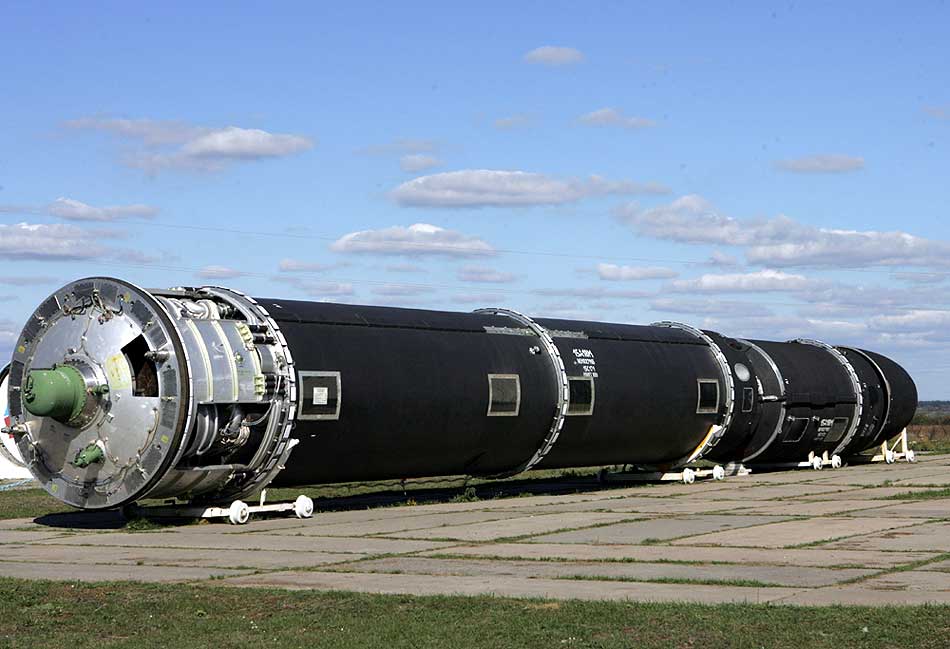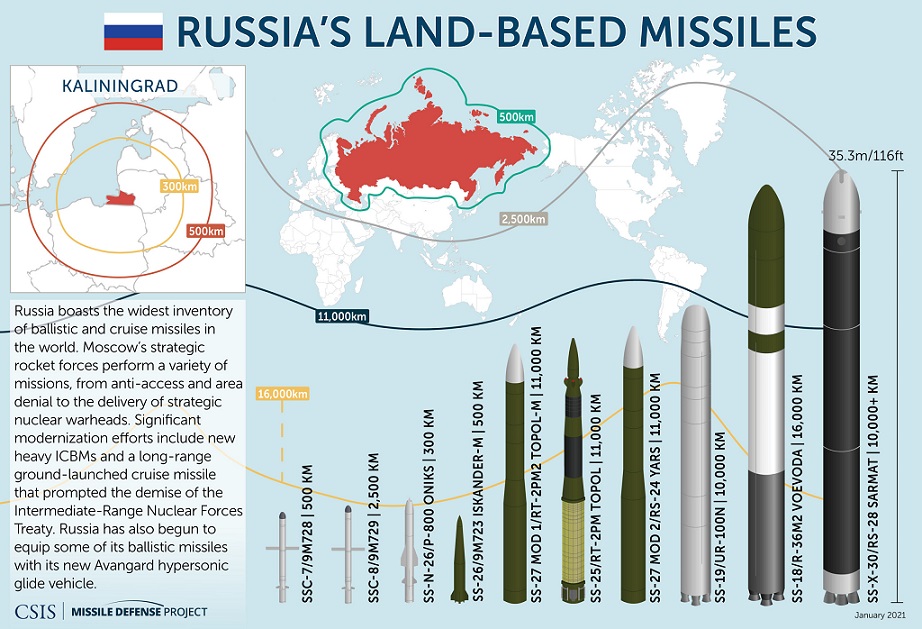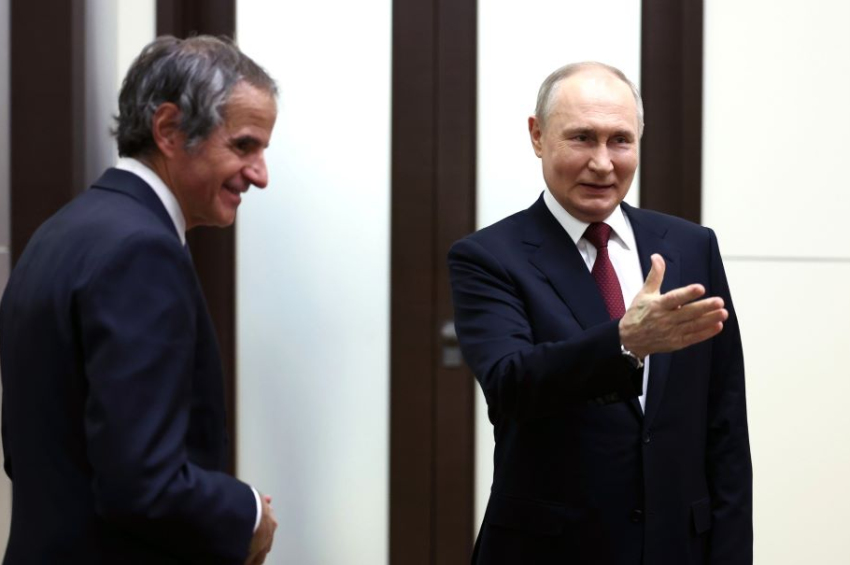Does Belarus host Russian nukes?
Russian Federation President Vladimir announced in late March 2023 that he has decided to transfer a part of tactical nuclear missiles to the Republic of Belarus, at the request of his counterpart in Minsk, with the aim of protecting the two countries from a possible NATO attack.
The parties did not specify whether the nuclear weapons will only be hosted by Belarus under Russian management or integrated into local armed forces with Alexander Lukashenko in control of the "red button".
Putin also said, among other things, that Russia has developed nuclear-fueled missiles, that ballistic missiles have been fitted with wings and are capable of flying undetected over the South Pole before hitting targets on the North American continent. In the following article, we will try to answer the main questions regarding the strategic nuclear arsenal and ballistic missiles that Putin boasts about.
To filter facts from falsehoods, News-Cafe.eu has consulted dozens of sources dedicated to security issues, including the United Nations Organization, the International Peace Research Institute in Stockholm, the Atlantic Council, Foreign Affairs, Meduza, Novaia Gazeta, Wikipedia, and ChatGPT.
NUCLEAR WEAPONS IN BELARUS
1. Infrastructure
During the period when Belarus was part of the USSR, a significant number of nuclear warheads, 1,100 to be exact, were stationed in the republic, so in theory the country has the infrastructure to accommodate medium- and long-range missiles. However, this is unlikely to happen.
Firstly, due to physical degradation - the bases have long been closed, and the government in Minsk has not invested in maintaining the silos without any practical purpose. If it comes to shipping nuclear weapons to Belarus, the costs of their modernization will be enormous. Belarus will surely pass the bill to Russia.
Secondly, with the Russian budget groaning under Western sanctions and the military complaining of an acute shortage of conventional weapons and corruption in the armed forces, the Russians simply don’t have a couple of billion dollars they need to invest in the defense of 207,000 square kilometers of foreign territory. In addition, the logistical effort would take around 10 years.
2. Trust
Although they are allies, Putin and Lukashenko do not trust each other. Yes, the two dictators collaborate, but they do so out of necessity - both have usurped power, stay at the rule thanks to the brute force, and are under international sanctions. In reality, their strategic goals are diametrically opposed: Putin wants to restore the empire, in which Belarus would be a Russian province, and Lukashenko wants to maintain his country independent but continue receiving cheap gas from the Russians. Moscow and Minsk have been struggling for 20 years to give birth to a union state, and yet they can’t.
Lukashenko would probably like to acquire nuclear missiles, but for the same purpose that the Chechen leader Ramzan Kadyrov requested anti-aircraft defense systems from Moscow last year: in case of a future armed confrontation with Russia. The example of Ukraine, which gave up its nuclear weapons in exchange for a piece of paper worthless today, certainly made the dictator think.
3. Consequences
Russia and Belarus have signed the International Treaty on Non-Proliferation of Nuclear Weapons, which prohibits the transfer of nuclear weapons to non-nuclear states. Violating the treaty would result in new sanctions, loss of the few allies, and an escalation of the nuclear arms race. For example, Poland and Ukraine would be morally justified to acquire nuclear missiles.
Apart from political risks, there are security risks: transporting nuclear weapons while an active war is waged in the neighboring country is pure madness. And we are not talking about an act of hijacking or terrorist/military attack, but a simple accident during shipping, installation, or storage.
The conclusion on "Nuclear Weapons in Belarus": bluff, disinformation.
NEW RUSSIAN ROCKETS
Putin has boasted on several occasions that Russia has successfully manufactured and tested a new ballistic missile called "Sarmat". He also mentioned that the arsenal capable of nuclear attacks includes "Burevestnik", "Voyevoda" (also known as "Satan"), "Avangard", "Yars" (also known as "Topol"), and others.
1. What is ”Sarmat RS-28”?
Putin keeps assuring since 2016 that this type of liquid-fueled ballistic missile is "practically ready".
It was successfully tested for the first time on 20 April 2022. The missile - 35.5 m tall, 3 m in diameter, and a weight of 208 tons - is capable of carrying 10 real warheads and 40 decoys as far as 18,000 km, according to official information.
In 2017, tests were conducted with prototypes powered by common explosives, and then they discovered that one-third of the 3.2 billion rubles allocated for this missile tests had been stolen. In total, there have been six launches, which is a small number for an experimental cycle of such a sophisticated weapon.
"Sarmat," which is set to replace the "Voyevoda R-36M" missiles, has not yet been delivered to the armed forces, and Russia's production capacity is estimated at 6 units per year.
2. What is ”Voyevoda R-36M”?
The Russians want to retire the respective missile from active service for two reasons. The first is that the projectile is physically obsolete. The substance that propels it - dimethylhydrazine - is highly toxic and reactive. Before deployment, the liquid is poured into the rocket, and after deactivation for passive mode, it must be drained. It "eats" any material and after 30 years of use, it turns into scrap metal. The latest version of the missile was delivered in 1988.

The second reason is that this 209-ton projectile 18-32 meters tall and 3 meters in diameter is a Ukrainian brand product. Its body was manufactured in Dnipro, a city in central Ukraine, and the control system in Kharkiv, the east of the country. After the occupation of the Crimean Peninsula and the beginning of war in Donbas in 2014, the Kiev government canceled the contract with Moscow and stopped supplying components or servicing the missiles it had sold to Russia. In 2020, the Russian arsenal had less than 40 pieces of this kind.
What did the Russians do? They plagiarized "Voyevoda" and obtained "Sarmat" after rebranding. In NATO’s military classification, they are known as "Satan-1" and "Satan-2". Is the Russian "Voyevoda" still capable of breaking away from the ground and fly the declared 10-16 thousand kilometers or not... we can only guess.
3. ”Avangard”
We would like to clarify from the outset that "Avangard" is not a rocket - it is a warhead installed on the "Yars" missile (a modified version of the "Topol RT-2PM-2" missile based on solid fuel). When "Sarmat" is ready, it will carry "Avangard" warheads.
The conclusion on "New Russian Rockets": the existence of a limited number of missiles is confirmed, but the safety of the missiles is unclear and their functionality is uncertain.
PERFORMANCE OF PUTIN'S WEAPONS
The Kremlin leader has assured that the Russian super weapons have been equipped with "winglets" for better navigation, can fly undetected by circumnavigating the South Pole before hitting targets on the North American continent, are powered by nuclear fuel, while the European defense systems are useless against these weapons and, in general, some of them "can destroy half a continent, if we wanted to" (according to Dmitry Rogozin, the former head of Roskosmos).
1. Nuclear-powered propulsion
News-Cafe.eu intentionally omitted information about the "Burevestnik," because this ghost missile has a spicy story behind the genius of Putinist engineers. Vladimir Putin first spoke about this missile in an address to the National Assembly in March 2018.
Its specific feature is the nuclear engine, which "ensures unstoppable speed and unlimited flight time" - to quote the Russian leader.
The concept isn’t new; the Soviets even manufactured a prototype, but they abandoned the idea almost immediately. Imagine a projectile with uranium or plutonium as fuel. When the air passes through its body and is ejected after combustion, gigantic amounts of radioactive elements are released into the atmosphere. The military realized that, instead of defending the country from a possible nuclear attack, they were actually contaminating it with their own weapons. Radioactive fallout will spread over a vast area along the missile’s trajectory. Nuclear warheads are not even necessary, as the engine alone would be enough.
That is if the missile flies towards the intended target. What happens if it falls on its own territory? That's precisely what happened with the "Burevestnik" in August 2018 at the Nyonoks test site in northeastern Russia. Roshidromet, the atmospheric quality monitoring service, later confirmed a whole bunch of radioactive substances in the given area: Strontium-91, Barium-139, Barium-140, Lanthanum-140... products emerging from the decay of short-lived isotopes of inert gases - krypton and xenon, which are contained in the missile fuel.
After the Kremlin handed out medals in connection with this experiment, probably as a sign of gratitude to God that the reactor did not explode, propaganda has gone the silent mode. In any case, no one has seen the "Burevestnik" missiles since then.

Russian, tactical and ballistic missile range, according to NATO classification.
2. Winglets as the fifth wheel to a wagon
There is a consensus among long-range rocket engineers that in order to target more accurately and have a smaller mass, the warhead body should have a shape as simple as possible. The wings need to be covered with ceramic material for thermal protection during atmospheric friction, which adds to the weight of the warhead and rocket, requiring additional fuel, but reduces precision and maneuverability.
For example, the "Avangard" warhead weighs 4 tons, compared to 800 kg for older warheads. If the future "Sarmat" takes on more than two of these warheads aboard, it will simply crash immediately after takeoff or will not take off at all. Putin's wings would create additional technical problems.
3. The flight over the South Pole
Every projectile is designed to reach its target as quickly as possible, ideally without being detected by the enemy. Why Putin needs to attack America through the South Pole, burning an awful lot of fuel and avoiding European air defense systems, when his country is only separated from the US by a strait of just 80 km, is very unclear. Why can't he attack from a submarine in the Pacific Ocean? The question belongs more to the realm of psychiatry, because from a technical-military point of view it is nonsense.
4. Defense against hypersonic missiles
However, when it comes to the ineffectiveness of European defense systems against hypersonic missiles, Putin is right. A missile launched from a low Earth orbit - we emphasize, any missile - accelerates to a speed of 20 Mach (21,200 km/h) after entering the atmosphere. No country in the world is capable of destroying or deflecting a projectile coming at such a speed. Including the US, China, or Russia. Neither Americans, Europeans, nor anyone else has set the objective of creating a defense system against ballistic missiles with multiple nuclear warheads. It's a waste of money.
The conclusion on "Performance of Putin's weapons ": a trick to intimidate opponents.
The purpose of the rattling with nonexistent weapons
However, it isn’t for nothing that Putin has brought the issues of nuclear capacity building in Belarus and strikes with super-winged hypersonic missiles just over the South Pole.
The problem is that, against the background of the rapid melting of the Russian budget, more and more countries are refusing to buy fuel from Putin, including some allies. The latest blow comes from Chinese leader Xi Jinping, who, after assuring Comrade Putin of fraternal support during a recent visit to Moscow, has declined to sign a new contract for the delivery of Russian gas.
The main reason, however, is that the Ukrainian army has received new (and shining) weapons, its soldiers have completed training, and now Ukraine is preparing for an offensive. While the Kremlin is shaking the air with the supremacy of its weapons - many of which are non-existent or in the same poor condition as the "Armata" tanks, which made the Russians look like fools during the parade in May 2015 - Kiev has secured for itself real "Leopards" and "Patriots" to start hunting the unwanted guests.
Russia simply won't have anything to respond with. What is can do, however, is to show animated pictures of missiles sneaking over computer-generated landscape and to bluff all over again.







